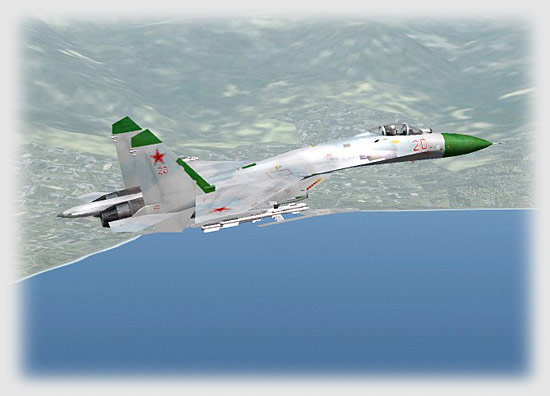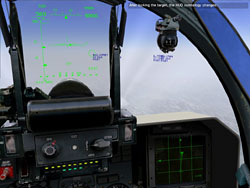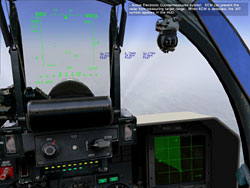
Preview
Lock On (v1.1): Flaming Cliffs
Part 2 - Let's
Talk Avionics: New Radars for the Russian Fighters
by Cat
For me, the most important change in Lock On (v1.1): Flaming Cliffs is one that a lot of people won’t pay much attention to. We at last have access to the most realistically modeled air radar seen in a sim since the Falcon series. What Eagle did for the AN/APG-63 in the F-15C, they have at last done for the Su-27’s N-001 and the MiG-29’s first-generation N-019 radars…only more so. More than new radar modes have been added. The team has tweaked radar performance in all the aircraft. Radar jamming gate has been overhauled. ECM burn-through ranges are now modeled more precisely. Doppler effects are better modeled. And there’s more.
FC actually looks at the geometry, how the target is presenting in relation to the emitting platform. This is most prevalent in the Russian aircraft, because the Russian radars have to be set for front-aspect or rear-aspect targets to perform most efficiently.
To understand this, we have to look at the new radar modes.
 FC
now models the N-001 and N-019 radars as they are found in aircraft built prior
to about 1989. You’ll find two beyond-visual-range master modes and three
sub-modes, along with a vertical scan close combat mode, a radar spotlight mode,
a missile seeker mode and the helmet targeting mode. Only the helmet mode is
unchanged from previous versions of the game. All the rest are so different
as to be barely recognizable. Excited? I sure am.
FC
now models the N-001 and N-019 radars as they are found in aircraft built prior
to about 1989. You’ll find two beyond-visual-range master modes and three
sub-modes, along with a vertical scan close combat mode, a radar spotlight mode,
a missile seeker mode and the helmet targeting mode. Only the helmet mode is
unchanged from previous versions of the game. All the rest are so different
as to be barely recognizable. Excited? I sure am.
You will remember that the original Flanker’s BVR master mode was “DVB,” and this mode showed radar contacts on the HUD. The system chose which one to lock up, and you had very little control over which ones the system picked. Later, as the game evolved into version 2, DVB was changed to allow the player to use a scan box to designate targets and the old DVB mode was basically dropped. DVB mode was later enhanced with a TWS-style mode that allowed silent launches on multiple targets, which even modern N-001 radars still can’t do, and in Lock On v1.02 the TWS modes were removed totally. That’s all changed now.
DVB “Scan” (looks like Ob3 in Cyrillic) is the Russian version of Range-While-Search, and looks now like what you’d find in a real pre-1989 aircraft. It has three sub-modes.
 First
is the high pulse-repetition frequency forward-hemisphere submode, which in
Russian is designated “PPS” in the game.
First
is the high pulse-repetition frequency forward-hemisphere submode, which in
Russian is designated “PPS” in the game.
You can tell which DVB submode is active by looking at the top left, next to the range scale. PPS, also known as “Head On,” or “Encounter” mode, is designed to detect targets in forward aspect with a closing velocity (Vc). The higher the Vc, the longer away the radar will pick up targets, just like Vector Search mode in Falcon 4.0’s simulated AN/APG-68. Unlike VS, though, PPS submode in the N-001/019 is more sensitive and less likely to lose targets with low closing velocity.
This is the most reliable of the three “Scan” submodes and the one real Russian pilots use most often. You have the same scan-zone box that you had before to lock onto the target. You have control of the radar dish in elevation, and to get full elevation and depression play of the radar dish, you have to manually set the target’s expected range fairly far out. You have azimuth control in three zones-left, center, and right.
 You
can flick the dish through the three zones and up/down fairly quickly if you
program the controls into your HOTAS. HUD indicators tell you what azimuth position
you’re in, where you’ve set the expected range, and where the dish
is in the vertical axis. It is important not to just set the range out long
so you can control the dish through its full range of motion, because unlike
American radars that automatically scan up and down in elevation two to eight
bars in any position, these don’t and you can find yourself taking too
long to get the dish around the horizon. You’ll lose your target that way.
You want to limit its travel and concentrate on a fairly narrow band of sky
where you’re looking for the target.
You
can flick the dish through the three zones and up/down fairly quickly if you
program the controls into your HOTAS. HUD indicators tell you what azimuth position
you’re in, where you’ve set the expected range, and where the dish
is in the vertical axis. It is important not to just set the range out long
so you can control the dish through its full range of motion, because unlike
American radars that automatically scan up and down in elevation two to eight
bars in any position, these don’t and you can find yourself taking too
long to get the dish around the horizon. You’ll lose your target that way.
You want to limit its travel and concentrate on a fairly narrow band of sky
where you’re looking for the target.
The second “Scan” submode is “ZPS,” also known as “Pursuit” submode. This medium-PRF mode is best at detecting rear-aspect, receding targets for when you are in a stern chase.
The third “Scan”
submode is the default, and it is “AVT” submode, also known as “Automatic”
submode. This is an interleaved high/medium PRF mode, and its range is cut by
about 25% over PPS and ZPS due to that. It is the default DVB-Scan submode,
and is probably the least overall  reliable
of the three due to its lessened range. However, it will burn through jamming
a little faster and it is more discriminating at target selection than PPS or
ZPS. It is the closest analogue to an American range-while-search radar mode
such as vanilla RWS in the F-15C’s APG-63.
reliable
of the three due to its lessened range. However, it will burn through jamming
a little faster and it is more discriminating at target selection than PPS or
ZPS. It is the closest analogue to an American range-while-search radar mode
such as vanilla RWS in the F-15C’s APG-63.
Some sources indicate that there should be a fourth DVB-Scan submode, called “Free Search.” This is another high-PRF mode similar to PPS, but its main difference is that it is intended to, and programmed specially to, reject countermeasures such as chaff. Free Search is not in the game, but you won’t miss it. This submode is so much like PPS as to be indistinguishable for most users.
The second DVB master mode is DVB-SNP, (looks like CHn in Cyrillic) which is the track-while-fly automatic engagement mode, the early Russian version of track-while-scan. In FC, you have to be in the PPS or ZPS “Scan” submodes to access SNP master mode.
Now, as I stated above, the interleaved-scan submode is abbreviated in-game “AVT,” or “af-to,” in Cyrillic. In other words, “Auto.” You may have read that this submode should be linked to the “automatic” tracking function of the track-while-fly SNP master mode rather than the PPS or ZPS submodes. In "Easy Tartar’s" review of the MiG-29’s radar here, he indicates this to be the case. I think Eagle’s got it right and “Auto” mode is correctly modeled. I got the scoop from none other than Oleg Tishenko-Eagle’s avionics genius. Be sure: how can ya go wrong on a technical flight sim question with a guy named Oleg? Anyway, Oleg’s point is that the for-real MiG-29 manual (how cool is that, readers?) they’re using at Eagle to model this functionality has “Auto” submode as the only one of DVB-Scan’s submodes that can’t enter SNP master mode. Look below for the reason why this is. And this would mean that the “Auto” in the title of Auto submode refers to the automatic switching from high to medium PRF and back again as the radar scans, rather than a link to SNP mode. Oleg sent me this interesting tidbit, via Matt Wagner, on how actual MiG-29 and Su-27 pilots get into SNP mode:
In real life, the TWS on Russian aircraft works in this manner:
MiG-29
TWS can be engaged ONLY if you was set radar to V (VSTRETCHA - closing to target) or D (DOGON - pursuit of target) by rotary "radar mode switch" and if you set "ZPS-PPS" switch (note it is another switch) to ZPS (ZADNYAYA POLUSHPERA - rear hemishpere), or to PPS (PEREDNYAYA POLUSHPERA - front hemishpere). These two switches must be correlated between each other. "D" corresponds to "ZPS", and "V" corresponds to "PPS". Overwise TWS-mode will not be engaged.About PFR. PFR - Pulse Frequency Rate. "V" corresponds to high PFR, and
"D" to medium PFR. In the AVT (AUTO) radar mode there is interleaved PFR. Interleaved PFR it is when frequency rate is switched between high and medium rates at each radar antenna scan period. This is the reason why TWS can not be engaged in AVT (AUTO) radar mode.Su-27
At Su-27 the "PPS-AVT-ZPS" switch toggles both PFR and ability to engage TWS mode. In AVT position you can not to engage TWS respectively.
 This
little piece of radar trivia aside, which I’m sure hardcore simmers will
ENDLESSLY and joyfully debate on our boards, what DVB-SNP master mode does is
prioritize targets for you. It will place the target designator box over the
target with highest closing velocity, thus bugging it for you automatically,
and track it without locking on until you’re in optimal engagement range
for your selected weapon. However, unlike an American track-while-scan setup
(cf. the F-15C’s APG-63), you don’t get Vc or aspect info on the bugged
target. And since this is an early radar, you only have the ability to mark
one target for termination. Once you’re in launch parameters for the selected
ordnance, the system will automatically go into Attack (single-target-track)
mode and ready a missile for firing. Post-1989 or so radars, like that found
in later Su-27SMK aircraft, can prioritize and guide RVV-AE missiles to two
targets, more like an American TWS setup can do with AMRAAM.
This
little piece of radar trivia aside, which I’m sure hardcore simmers will
ENDLESSLY and joyfully debate on our boards, what DVB-SNP master mode does is
prioritize targets for you. It will place the target designator box over the
target with highest closing velocity, thus bugging it for you automatically,
and track it without locking on until you’re in optimal engagement range
for your selected weapon. However, unlike an American track-while-scan setup
(cf. the F-15C’s APG-63), you don’t get Vc or aspect info on the bugged
target. And since this is an early radar, you only have the ability to mark
one target for termination. Once you’re in launch parameters for the selected
ordnance, the system will automatically go into Attack (single-target-track)
mode and ready a missile for firing. Post-1989 or so radars, like that found
in later Su-27SMK aircraft, can prioritize and guide RVV-AE missiles to two
targets, more like an American TWS setup can do with AMRAAM.
In the final analysis, the new radar combat modes get two thumbs and a big toe up from me. They’re my hands-down favorite added functionality in the game, even more so than the new aircraft. They’re great fun to fiddle with, realistic as heck, and rather more intuitive than the previous setup for Russian aircraft once you get used to it.
 You’ll
like this: Russian jets now have lock-on-jam available in DVB-Scan mode. You
cannot go to DVB-SNP in an ECM environment. In DVB-Scan’s three submodes
(PPS, ZPS, and Auto), you will get jamming strobes that flicker in a vertical
band of static across the HUD, and you can command a manual lock-on. Once you
do, you will not get any ranging info. You’re firing blind. Call your AWACS
for range to target, and once you’re in range, manually set the range carat
using your radar range keys and fire! The R-27R/RE and R-77 (RVV-AE) can all
track a jamming target, and will default to direct radar guidance or the onboard
radar for the R-77 once burn through happens or the target quits jamming. And
now these missiles initially guide by inertial updating from your aircraft datalink,
much like an AMRAAM does! This means that if you lose lock for an R-27, the
missile will use the link to guide via inertial guidance to the target’s
last known position. It will re-acquire if you re-acquire the target. R-27R/RE
missiles have just become more deadly in the hands of a skilled f-pole jouster.
You’ll
like this: Russian jets now have lock-on-jam available in DVB-Scan mode. You
cannot go to DVB-SNP in an ECM environment. In DVB-Scan’s three submodes
(PPS, ZPS, and Auto), you will get jamming strobes that flicker in a vertical
band of static across the HUD, and you can command a manual lock-on. Once you
do, you will not get any ranging info. You’re firing blind. Call your AWACS
for range to target, and once you’re in range, manually set the range carat
using your radar range keys and fire! The R-27R/RE and R-77 (RVV-AE) can all
track a jamming target, and will default to direct radar guidance or the onboard
radar for the R-77 once burn through happens or the target quits jamming. And
now these missiles initially guide by inertial updating from your aircraft datalink,
much like an AMRAAM does! This means that if you lose lock for an R-27, the
missile will use the link to guide via inertial guidance to the target’s
last known position. It will re-acquire if you re-acquire the target. R-27R/RE
missiles have just become more deadly in the hands of a skilled f-pole jouster.
Radar close combat modes are a little different. Although the “Boresight” searchlight mode is no different, the Vertical Scan mode now locks on automatically when a target is in the HUD scan area. Also, the FIO missile-seeker-lock-on mode is VERY different, because it will lock on automatically when you’re using an IR missile! It works very much like a “Visual” AMRAAM launch in the F-15, except you get tone in your headset when the missile is locked to its target. If you can see it, you can kill it, even when you have no HUD. Put it in the center of the combining glass, wait for the tone, and let fly! Also, in Attack mode for all radar modes, there is now a dot in the HUD that tells you where the center of your radar scan zone is. Keep it in the HUD, or gimbal-lock your radar!
 The
EOS has been fine tuned and now will pick up targets in front aspect as far
away as 25 kilometers, depending on size and heat signature. You cannot target
radar missiles of any type with it, but you can coordinate stealth attacks with
R-27T/TE missiles and R-60/73 close combat missiles. You cannot have both radar
and EOS active simultaneously.
The
EOS has been fine tuned and now will pick up targets in front aspect as far
away as 25 kilometers, depending on size and heat signature. You cannot target
radar missiles of any type with it, but you can coordinate stealth attacks with
R-27T/TE missiles and R-60/73 close combat missiles. You cannot have both radar
and EOS active simultaneously.
In closing, I think that the new changes to the N-001 and N-019 radar are in many ways a throwback to the days of sims like Falcon 4.0, in the avionics department. No, these Soviet-era radar are not as complex as Falcon's AN/APG-68 is, but the real Russian radar aren't, either. They're different systems, born half a world away and engineered by people with a totally different air combat philosophy than Western sim-aviators are used to. I find them oddly dynamic and intuitive, and at the same time their limitations give one a great appreciation of the West's technical superiority that continues to this day in the current generation of combat aircraft. Even though it is getting long in the tooth, the current-day F-15C can still stand toe-to-toe with the best the rest of the world has to offer. Thanks to Igor Tishin and his Eagle Dynamics crew, the combat aircraft that much of the rest of the world depends on can also be seen and flown in the virtual skies. I'm glad to see it, and will greatly enjoy flying the Su-27 and MiG-29 in the future thanks to these changes. Expect Lock On: Flaming Cliffs to be released toward the end of the year, in CD form for Russia, and via direct download for the rest of the world. It's a good investment for anyone who loves this series of sims and enjoys flying Soviet-era combat aircraft. Don't miss it.
System Specs
Copyright 2008, SimHQ.com. All Rights Reserved. Contact the webmaster.